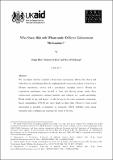| dc.contributor.author | Barr, Abigail | en |
| dc.contributor.author | Dekker, Marleen | en |
| dc.contributor.author | Fafchamps, Marcel | en |
| dc.coverage.spatial | sub-Saharan Africa | |
| dc.date.accessioned | 2016-06-23T14:44:31Z | |
| dc.date.available | 2016-06-23T14:44:31Z | |
| dc.date.issued | 2010 | en |
| dc.identifier.uri | https://opendocs.ids.ac.uk/opendocs/handle/20.500.12413/11827 | |
| dc.description.abstract | We investigate whether available enforcement mechanisms affects who shares risk
with whom in sub-Saharan Africa by applying dyadic regression analysis to data from a
lab-type experiment, surveys and a genealogical mapping exercise. During the
experiment participants were invited to form risk sharing groups under three
enforcement mechanisms: external, intrinsic, and extrinsic, i.e., social sanctioning.
Dyads similar in age and gender or who belong to the same economic communitybased
organizations (CBOs) are more likely to share risk. However, when social
sanctioning is possible, co-members in economic CBOs withdraw from group
formation and co-religion and marriage ties come to the fore. | en |
| dc.description.abstract | Barr, A. et al. (2010) Who shares risk with whom under different enforcement mechanisms? ESRC Working Paper, London: ESRC. | |
| dc.language.iso | en | en |
| dc.relation.ispartofseries | ESRC Working Paper | en |
| dc.rights.uri | http://creativecommons.org/licenses/by-nc-nd/4.0/ | en |
| dc.subject | Social Protection | |
| dc.title | Who shares risk with whom under different enforcement mechanisms? | en |
| dc.type | Series paper (non-IDS) | en |
| dc.identifier.externaluri | https://doi.org/10.35648/20.500.12413/11781/ii045 | |
| dc.identifier.ag | RES-167-25-0372, ES/F027532/1 | en |
| dc.identifier.doi | 10.35648/20.500.12413/11781/ii045 | |


